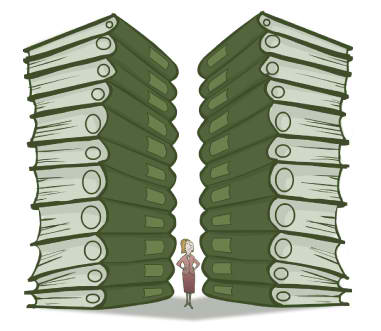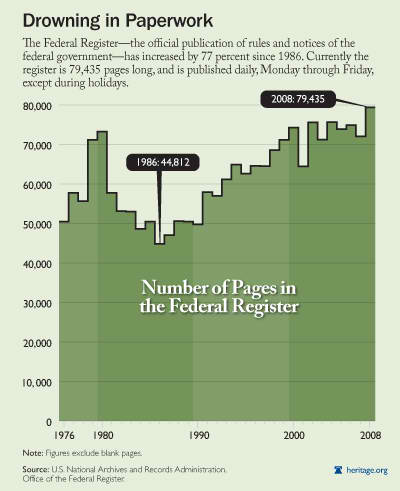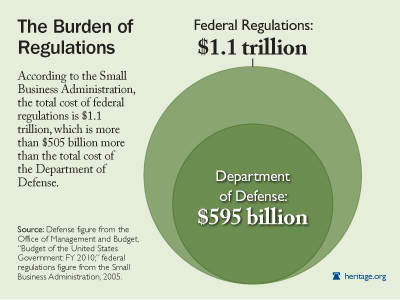How the flood of regulations hurts Americans
When Regulations Attack
Over the years, George Norris, an elderly retiree, had turned his orchid hobby into a part-time business run from the greenhouse behind his Texas home. He would import orchids from abroad—South Africa, Brazil, Peru—and resell them at plant shows and to local enthusiasts. He never made more than a few thousand dollars a year from his orchid business, but it kept him engaged and provided a little extra money for him and his wife.
George Norris’s life would take a turn for the worse on the bright fall morning of October 28, 2003, when federal agents, armed and clad in protective Kevlar, raided his home, seizing his belongings and setting the gears in motion for a federal prosecution and jail time.
Trade in orchids, you see, is regulated by an international treaty, the Convention on International Trade in Endangered Species (CITES). Though initially conceived to protect endangered animals, it was expanded to include flora as well. The U.S. Endangered Species Act (ESA) was amended in 1981 to include the species listed in CITES, which put George Norris in violation of federal law.
These regulations make orchid trade really complicated, since there are thousands of varieties, many of which are indistinguishable to all but the experts. Ironically, the trade overall may not even endanger the rare varieties, since traders and collectors have every incentive to artificially propagate the plants. So, not surprisingly, there is a thriving black market in the orchid trade.
Norris, however, had spent years following the mind-numbing procedures to trade orchids legally. Still, some paperwork errors eventually put him in the crosshairs of the U.S. Fish and Wildlife Service. It cost him years of his life, his retirement savings, and his faith in American justice system. To avoid greater costs he eventually pled guilty and was sentenced to 17 months in prison, including 71 days in solitary confinement, followed by two years of probation. He and his wife still owe $175,000 in legal fees.[1]
As Norris’s story shows, bad regulations can be truly harmful. They can cost us our time, our money, our freedom, and our dignity. In some cases, they can even cost us our health, our safety, and our life.

When Rules Violate Rather than Protect Our Freedom
A free society needs the rule of law. As C.S. Lewis once said, “There cannot be a common life without a regula [rule]. The alternative to rule is not freedom but the unconstitutional (and often unconscious) tyranny of the most selfish member.”[2]
The best purpose for government is to maintain the rule of law—to preserve and defend those conditions which allow individuals and families to pursue lives of freedom and virtue. Since I have the right to protect myself and my family from theft, murder, and enslavement at the hands of others, I can delegate the defense of that right to the government. Therefore, when the government protects the life, liberty, and property of my family, it allows me to be more rather than less free.
Thus we have the need for laws against such things as murder, theft, and fraud. They’re not much different from the laws inscribed on the second tablet of the Ten Commandments—don’t murder, don’t steal, don’t lie. The problem comes when the rules begin to violate, rather than protect, my rights to life, liberty, and property.
Even rules with a good purpose—such as protecting the environment or defending us from terrorists—can be ill-conceived, putting in place too many limits at too great a cost. Some even can reduce our safety or health even when they’re meant to protect it.
In addition, many rules are simply beyond the government’s proper role. Rather than just protecting our freedom to live our lives under the rule of law, government often tries to decide for us, in detail, how we should live. Instead of being a fair referee, government starts calling the shots. Such interference can take many forms—from deciding how we can educate our children and what medical care we can receive, to restricting what political views we can hear on the radio. For example, through economic rules, it can limit the cars or the clothes you can buy.
Some may think that these are minor restrictions on our freedom. Others might think of them as, at worst, mere nuisances, like the countless documents we need every time we visit the Department of Motor Vehicles. Still others see them as signs of an ever more intrusive Nanny State.
Balance of Power
“If men were angels, no government would be necessary. If angels were to govern men, neither external nor internal controls on government would be necessary. In framing a government which is to be administered by men over men, the great difficulty lies in this: you must first enable the government to control the governed; and in the next place oblige it to control itself.”
—James Madison, Federalist #51
In any case, somewhere along the line, a government that creates too many regulations actually violates the rule of law. This is obvious when the government destroys your livelihood because you made a couple of mistakes on a form—as it did to George Norris. It’s less obvious with the countless regulations that slowly fill the stage sets of our daily lives, one prop at a time—until we start getting crowded off the stage.
Overcriminalization
Overregulation leads to overcriminalization. Overcriminalization occurs when it becomes almost impossible for ordinary, law-abiding citizens to carry on their daily lives without violating some obscure law, thereby incurring the wrath of the government. Such policies end up not only punishing the innocent, but debasing the rule of law.
As we’ll see, it’s possible to be a victim of too many regulations, a victim of a bad regulation, or both.
That’s what happened to George Norris.
The Cost of Regulations
Did you know that for much of its history, the federal government cost every citizen only about $20 a year (in current dollars)? For decades, the only federal employee most people encountered was the mailman. Now the federal government costs each of us about $10,000 a year.
Some 60 agencies have a hand in federal regulatory policy, ranging from the Environmental Protection Agency (EPA) to the Securities and Exchange Commission (SEC) and the Food and Drug Administration (FDA). Together, they enforce over 157,000 pages in the so-called Code of Federal Regulations. Consider that in 1950 this document contained just 9,745 pages. That’s an increase of 1,621%.”[1] To give you a better idea on the amount of paper, think of two stacks of Bibles with really thin pages reaching from the floor to the ceiling in a room with a twelve foot ceiling, and you’ll get the basic idea. But rather than psalms, proverbs, gospels, and epistles, the rules on these pages are meant to protect our health and safety, to protect us from con-men and dangerous jobs, to protect (or suppress) economic competition, and to protect the environment from us.
Some of these regulations are quite helpful. For instance, anti-fraud rules and, arguably, the do-not-call rules for telemarketers[4] actually reinforce individual and property rights. And even while we debate the details, most would agree that we need security rules to protect us against terrorism and environmental rules to keep people from dumping poison on others’ property. Good regulations along these lines, like the rule of law itself, don’t violate our freedom overall. They protect it.
Still, all regulations have a cost. You can think of the total burden of all regulations—good, bad, or indifferent—as a “regulatory tax” imposed on all Americans.
First, there are direct costs. A universal mandate to buy health insurance costs us all the time and money it takes to get the insurance. It also has hidden costs: the extra money we must pay because the government makes us buy it. Since we’re a captive market, insurance companies can charge more than if everyone were free to buy or not buy the insurance.
Then there’s the cost of compliance. Ford Motor Company, for example, has to hire lawyers, accountants, engineers, and other experts simply to fill out paperwork, monitor employees, and so forth, to ensure that it is following the government guidelines. The more regulations, the greater the cost. That cost is money not being spent researching and building better, safer, less expensive cars.

Next is the economic cost on American firms, which now have to compete with foreign firms that are less burdened by regulations.
Finally, there are the “invisible costs.” Even for many economic regulations, the major cost may not be any direct burden placed on consumers or businesses, but constraints on innovation. We can’t assess such losses because we can’t measure the costs and benefits of inventions that never have been invented. We see their value only after the fact. In a high-tech economy, these unmeasurable and unintended costs are perhaps more harmful than the direct, measurable burdens. We’ll talk more about this below.

Of course, there’s no bottom line indicating how much we pay for these regulations. We don’t file regulatory tax forms on April 15. Yet hidden regulatory costs—just the ones we can calculate—are staggering. According to the Office of Information and Regulatory Affairs (OIRA), the White House office responsible for reviewing and tracking federal rules, regulations adopted in the past 10 years cost Americans $34 billion to $38 billion annually.[5] All federal regulations, OIRA states, could be costing Americans 10 times this amount: some $380 billion.
However, these numbers are low compared to estimates prepared by economists for the Small Business Administration.[6] In 2005, they concluded that regulations cost Americans $1.1 trillion. This is almost half of the amount collected in federal taxes and close to the $1 trillion paid in personal income taxes each year.[7] [8] The total cost of regulation is almost a tenth of America’s gross domestic product (a way of measuring the size of our economy) and more than half of the manufacturing sector’s output.

Even these numbers may underestimate the regulatory tax. For instance,
the study by the Small Business Administration does not include indirect costs. A regulation that increases energy costs would also affect other industries that require energy to produce their products.
Now every bill creating new regulations has some appealing name. The “Endangered Species Act” or the “No Child Left Behind Act” are good examples. Who wants to wipe out a species of animal or leave a child behind? Behind the glossy advertising, however, is always a hidden cost. In some cases, the costs of a regulation outweigh the benefit, whether hidden or unhidden. Whenever that happens, we have overregulation.
Economically, overregulation reduces economic growth, slows job growth, and reduces our income. It varies depending on the type of regulation,[9] of course, but the effect is clear. A recent World Bank study of regulation around the world revealed the connection between economic growth and regulation, finding that “[h]eavier regulation is generally associated with . . . more unemployed people, corruption, less productivity and investment.”[10] At the same time, the authors did not find a correlation with better quality of private or public goods.
The costs are not just economic. As we’ll see, regulations can—and often do—reduce our health and safety as well.
How We Get Regulations
The federal government restricts what we do through both legislation and regulation. It all starts when the U.S. Congress writes, debates, and sometimes eventually passes a bill (also called legislation) such as the Endangered Species Act. When the President signs the bill, it becomes law. That law may state broad goals, and then empower various government agencies to create, implement, and enforce various regulations intended to accomplish those goals. A single law, therefore, can lead to hundreds or even thousands of regulations, which may or may not accomplish the goals of the original legislation.
Deregulation: Trying to Trim the Fat
Since even good regulations can become obsolete and since bad regulations do more harm than good, we have to learn to trim the fat.
Risk and Riskier
It’s wise to think through the unintended consequences of a regulation. In the real world, however, there’s no such thing as zero risk—only more or less risk. So the relevant question for any regulation is one of prudence, not perfect safety: Given the likely consequences of a regulation, do its anticipated benefits outweigh the costs? Is the gain worth the risk?
For instance, everyone knows it’s safer for airline passengers flying through turbulence to wear their seat belts. For years, the American Academy of Pediatrics has called on the Federal Aviation Administration (FAA) to mandate that infants under two be belted on commercial flights.[11] So why does the FAA still allow parents to hold young infants—unbelted—on their laps? It’s the product of thoughtful analysis by federal regulators about the unintended effects of mandating seat belts (and so extra seats) for infants. Here’s how the FAA has explained the policy:
Analyses showed that, if forced to purchase an extra airline ticket, families might choose to drive, a statistically more dangerous way to travel. The risk for fatalities and injuries to families is significantly greater on the roads than in airplanes, according to the FAA. [In 2004] nearly 43,000 people died on America’s highways as compared to 13 on commercial flights.[12]
Even the American Academy of Pediatrics admits that “the risk of death or serious injury in an aircraft is exceedingly small.” In fact, from 1981 to 1997, there were only three reported deaths from injuries due to turbulence on commercial flights.[13]
Still, flying with an infant on your lap puts the child at some risk. So mandating infant seat belts on planes might save a few lives. Nevertheless, the unintended cost in lives of such a mandate vastly outweighs the benefits. Therefore, the FAA only urges but does not mandate seats for infants.
Since the 1970s, Presidents of both parties have tried to control the growth of new regulations, creating various agencies and initiatives to weigh their costs and benefits.[14]
In some cases, entire industries, such as the airline and telecom industries, have even been “deregulated.” Still, overall, these efforts have met with only limited success.[15]
Even when the government tries to look at the trade-offs of current and proposed regulations, the regulatory state has a way of growing anyway. That’s because legislators have a bias toward overregulation.
Why? Regulations, especially mandates, look cheap or even “free” from a budgetary standpoint, in contrast to programs that must be funded. Making everyone buy health insurance, for instance, seems less extravagant than taking over the entire health care industry, and attaching a huge payroll tax to pay for it all. The mandate isn’t free of course; it’s just moved from the federal budget to the budgets of individuals and families.
What is Seen and What is Not Seen
“There is only one difference between a bad economist and a good one: the bad economist confines himself to the visible effect; the good economist takes into account both the effect that can be seen and those effects that must be foreseen.
“Yet this difference is tremendous; for it almost always happens that when the immediate consequence is favorable, the later consequences are disastrous, and vice versa. Whence it follows that the bad economist pursues a small present good that will be followed by a great evil to come, while the good economist pursues a great good to come, at the risk of a small present evil.”
—Frédéric Bastiat[16]
More generally, the problem is the unseen cost of regulation. With regulations, the political focus is most often put on the “seen” effect, and the “unseen” costs are hidden from the public eye.
People see fuel shortages, pollution, and rising fuel prices, for instance. These evils may inspire legislators to force automakers to improve fuel standards. But the legislation may unintentionally lead to the deaths of thousands of people, as car companies make smaller cars that have better fuel economy but lower safety standards.[17] The legislators still get political points for “protecting the environment,” as long as voters don’t see the connection between the new regulation and the increase in deaths.
A Brief Miscellany of Bad Regulations
A quick Google search of “bad government regulations” can provide weeks of disheartening reading. Let’s consider just three bad regulations, as a sort of representative sample.
Withholding Treatment: Approving New Drugs and Medical Technology
The dilemma of the seen and unseen is especially acute when it comes to medical regulations.
One of the most spectacular achievements of American ingenuity over the past 50 years has been the development of medical devices and drugs that prolong life and improve health. From pacemakers to self-monitoring blood glucose kits and insulin pumps, new medical technology has saved the lives and improved the health of millions.
In the U.S., cardiovascular disease is the leading cause of death and disability. In recent years, though, new drugs and improvements in medical technology have improved survival rates significantly. Among the key innovations for treating heart disease are medical devices like implantable cardiac defibrillators that can treat deadly [irregular] heart rhythms and lower the risk of dying by up to 50 percent in some patients who have heart disease.
Stroke is the third leading cause of death in the United States and the leading cause of adult disability; in just the last 20 years, though, deaths from strokes have dropped from 36 percent. The major sources of improvement are new drug therapies as well as advances in brain and vascular imaging technology, which allow doctors to diagnose and treat patients more quickly.
The benefits from advances in health technology are clear. From 1980 to 2005, the annual death rate declined by over 23 percent while life expectancy from birth increased by 4.1 years. And from 1980 to 2000, disability rates for Americans over 65 declined by almost 25 percent.[18]
As in other areas, with medical regulations, unintended consequences can be hard if not impossible to see. Legislators and voters see the deaths resulting from complications with a drug, for instance, even if there’s “only” one death for every one million people who take the drug. So, in response to a few tragic deaths, legislators may push through new regulations that make it much more difficult to bring life-saving new drugs to market.
Pharmaceutical companies spend years on research and development, and hundreds of millions of dollars to get just one drug through the regulatory maze of the Food and Drug Administration (FDA). One estimate puts the cost at $806 million and 12 to 15 years for just one drug to go from conception to the drug store.[19] Well-meaning regulations can delay release and discourage risk and innovation with tragic consequences. One study followed the journey of Misoprostol, a drug designed to prevent gastric ulcers caused by aspirin. After years of logjams, the FDA finally approved the drug in 1988. In some other countries, in contrast, Misoprostol was available in 1985. Using the FDA’s own numbers, Sam Kazman of the Competitive Enterprise Institute determined that the delay of this one drug cost more than 20,000 American lives.[20]
Why do such things happen? Counterproductive, even deadly regulations persist in part because legislators, regulators, and activists get credit for the few visible lives saved, but don’t get the blame for thousands of lives lost. From a regulatory perspective, the thousands of deaths are invisible. A few deaths from an “unsafe” drug will make national headlines, and someone will get the blame. Few notice the thousands of otherwise preventable deaths from overregulation.
Let’s Throw a Little More Gasoline on that Fire: The 2008–2009 Financial Crisis
The 2008–2009 financial crisis has led many pundits and politicians to blame deregulation of the banking industry. What solution do they propose? More regulation. No doubt some regulations need to be reformed.[21] But many of these simplistic calls for “more regulation” are wrongheaded and potentially devastating.
First of all, banking is already one of the most regulated industries on the planet. Second, one of the many causes of the financial crisis was misguided government policies, that is, bad regulation.
The details are complicated, but the basic outline is pretty straightforward.[22] For years, government policies encouraged lenders to lower their standards for people qualifying for mortgages. The reason for these policies was to make home ownership more affordable for lower-income families.
A couple of government-sponsored enterprises, Fannie Mae and Freddie Mac, fanned the flames by purchasing risky housing loans with the (sadly correct) expectation that if they got into trouble, government would bail them out. That encouraged lenders to be lax in lending since they could easily sell their risky loans to someone else. A freer market would have discouraged such risky behavior.
This amounted to a government subsidy for risky home loans. And just as passing out vouchers to buy cars will drive up the cost of cars, this government subsidy for home loans inflated the cost of housing and encouraged many to buy homes that they could not afford.
There’s more to the story than this, but one thing is clear: Deregulation did not cause the 2008–2009 financial crisis. Bad government policy did.[23]
“Shoot, Shovel, and Shut Up”
The Endangered Species Act (ESA), which became law in 1973, is often credited with saving many species of animals and plants. But of the more than 1,200 plant and animal species designated as “endangered” or threatened, only 15—such as American alligators and gray wolves—have ever been “delisted.” Why this lack of success in bringing species back from the brink? One reason may be that the act unintentionally drives landowners to destroy habitats for endangered species rather than preserve them.
Under the ESA, the federal government can restrict landowners’ use of their property if a listed species’ habitat is discovered there.
Imagine a struggling Ohio corn farmer who discovers a certain wild lupine plant growing on the edges of his farm, populated by a few pretty blue butterflies. He decides to do a little research online and discovers that the Karner Blue butterfly, which is a designated endangered species, will only eat lupine like that growing in his field. With a little more searching, he finds that the government could designate his land a “butterfly habitat” and restrict him from farming on a large part of his land. Given the incentives, how likely is he to report his discovery to the U.S. Fish and Wildlife Service? Not very. And probably neither the lupine nor the pretty butterfly will make an encore appearance on his land.
One Texas cattleman put the matter plainly:
A landowner in his right mind would sooner welcome flesh-eating zombies onto his property than endangered species…. A man takes real good care of his land, some endangered species moves on there, and what’s his reward? The federal government coming in and restricting his ranch operations, that’s what.[24]
Obviously he’s much more likely to “shoot, shovel, and shut up.” In the summer of 2006, citizens implemented a variant of this policy, “saw, shovel, and shut up,” on a large scale in Spring Lakes, North Carolina. Audubon magazine described an epidemic of “chain-saw fever,” which launched the area’s “otherwise laid-back citizenry into a paroxysm of clear-cutting that reduced miles of shady, wooded lots to stumps and scorched white sand.” Who caused the frenzy? The U.S. Fish and Wildlife Service, when it announced its plan to update maps of trees in the area. Those trees happened to be the preferred nesting areas for endangered red-cockaded woodpeckers. Upon hearing the news, the landowners decided to make sure their pine trees did not get “’infested’ with wood-peckers,” which would bring down the regulatory zeal of the feds.[25]
This is a shining example of a bad regulation. Intended to protect endangered species, its real world outcome is sometimes just the opposite.
Fixing the Problems
There are often market-based solutions that work as well or better than a regulation. Often called “deregulation,” market-oriented solutions harness competition, better access to information, consumer choice, and market prices to shape desirable outcomes. Unfortunately, these solutions often take more thought, restraint, and political will than simple regulations, even if the regulations do the opposite of what they’re supposed to do.
As mentioned above, in the past we have successfully deregulated entire industries, such as telecommunications and the airlines.
The telecommunications industry was basically a government-enforced monopoly at one time (90 percent of long-distance revenues went to AT&T in 1984.) From 1984 to 1996, equipment and local and long distance service were all deregulated to one degree or another. Critics warned that chaos would ensue. In contrast, scores of start up companies emerged to compete with the monopoly, and we now have many more choices, much better service, and much lower prices.
The airline industry also was heavily regulated until 1978. Routes and prices were set by a government agency, not by consumer choice. Despite warnings of danger from opponents of deregulation, introducing market competition led to more choices and lower prices. Travelers today can buy an airline ticket for about half the price that they could in 1968 (adjusted for inflation).[26] And airlines have not become less safe as a result. Such is the power of the market.
In still other cases, transforming the role of regulatory agencies may be in order. To solve the problems resulting from delays in FDA drug approval, economist David Henderson offers this suggestion:
Pare back the FDA’s powers to that of an information agency. Require that any drug marketed without FDA approval tout that fact in big letters. And let us make our own trade-offs. Then those who want to avoid all drugs not certified by the FDA can do so; the rest of us can rely on the American Hospital Formulary Service or other private certifiers and thus have wider choices. Those who stuck with FDA certification would be no worse off. Those who tried non-FDA-approved drugs would be, by their standards, better off.[27]
Policy experts have proposed all sorts of creative ways to fix bad regulations. But politicians probably won’t implement them until we citizens—that includes you—hold them accountable not just for visible benefits of regulations, but for their invisible costs as well.
To read more on these topics, see:
- James L. Gattuso, “Reining in the Regulators: How does President Bush Measure Up?” Heritage Foundation Backgrounder No. 1801, September 28, 2004, at http://www.heritage.org/research/regulation/bg1801.cfm.
- James L. Gattuso, “Red Tape Rising: Regulatory Trends in the Bush Years,” Heritage Foundation Backgrounder No. 2116, March 25, 2008, at http://www.heritage.org/Research/Regulation/bg2116.cfm.
- James L. Gattuso, “Meltdowns and Myths: Did Deregulation Cause the Financial Crisis?” Heritage Foundation WebMemo No. 2109, October 22, 2008, at http://www.heritage.org/Research/Economy/wm2109.cfm.
- David C. John, “The Obama Financial Regulatory Reform Plan: Poor Policy and Missed Opportunities,” Heritage Foundation WebMemo No. 2545, July 15, 2009, at http://www.heritage.org/Research/Regulation/wm2545.cfm.
- Thomas Sowell, The Housing Boom and Bust (New York: Basic Books, 2009).
- Andrew M. Grossman, “The Unlikely Orchid Smuggler: A Case Study in Overcriminalization,” Heritage Foundation Legal Memorandum No. 44, July 27, 2009, at http://www.heritage.org/Research/LegalIssues/lm0044.cfm.
- John D. Graham, “The Perils of the Precautionary Principle: Lessons from the American and European Experience,” Heritage Foundation Lecture No. 818, January 15, 2004, at http://www.heritage.org/research/regulation/hl818.cfm.



